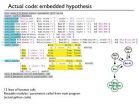(Press-News.org) Glioblastoma (GBM) is the most common primary malignant adult brain tumor and, despite treatment advances in recent years, the average survival of patients enrolled in clinical trials is less than 16 months with few patients living beyond five years. GBM tumors are characterized by angiogenesis — the formation of new blood vessels that support tumor growth stimulated by the GBM-produced vascular endothelial growth factor A (VEGF-A). Bevacizumab is a monoclonal antibody that targets VEGF-A production to block the growth of tumor-derived blood vessels. "Clinical trials evaluating the addition of bevacizumab to standard treatment for recurrent glioblastoma demonstrated clinical benefit and led to the drug's U.S. Food and Drug Administration approval for this indication," says Mark Gilbert, M.D., Radiation Therapy Oncology Group 0825 principal investigator and professor of neuro-oncology at The University of Texas MD Anderson Cancer Center in Houston. "Additionally, compelling preclinical data suggest that anti-angiogenic targeted therapies may normalize the tumor's rapidly forming and underdeveloped blood vessels, resulting in improved oxygen and chemotherapy delivery to the tumor and potentially enhanced radiotherapy (RT) and chemotherapy treatment," explains Gilbert. The Radiation Therapy Oncology Group (RTOG) 0825 study tested this hypothesis.
Six hundred and twenty-one adult study participants included in the study's final analysis were enrolled in the multicenter trial and randomized into one of two study arms, with treating physicians blinded to treatment assignment. All participants were treated with standard-of-care (60 Gy RT and daily temozolomide chemotherapy). Bevacizumab (experimental arm) or a placebo (standard treatment arm) was administered starting at week 4 of RT and continued every 2 weeks until 1) disease progression, or 2) severe treatment-related toxicity, or 3) completion of adjuvant therapy. At the time of disease progression, the treatment arm was unblinded allowing for follow on treatment with or without bevacizumab.
The authors reported data at a median follow-up time of 20.5 months, which revealed no statistical difference in overall survival between the two study arms (median 16.1 months for the standard-treatment arm vs. 15.7 months for the bevacizumab arm). Although there was a difference in progression-free survival (PFS) (7.3 months for the placebo arm vs. 10.7 months for the bevacizumab arm), the pre-established level of benefit for PFS was not reached. "The relevant result is that the upfront use of bevacizumab is not indicated," says Gilbert. "It's important to emphasize that the question we sought to answer was whether administering bevacizumab as first-line treatment improved survival; the cross-over component allowed comparison of risk and benefit of early versus late treatment We now know by giving it late you delay the risk of toxicity, and that may be relevant."
Study participants were stratified equally across study arms by prognostic molecular markers of tumor O6-methylguanine–DNA methyltransferase (MGMT) methylation status and a tumor-based 9-gene assay. Investigators, however, did not find a subgroup of patients based on the molecular marker analysis who survived longer from first-line bevacizumab administration. "We postulated that patients with worse prognosis, determined by their tumor markers, would do better if they received bevacizumab as first-line treatment because they may not survive to take advantage of, or do well enough to be considered for, second-line treatment, but we didn't find that result" says Gilbert.
Because bevacizumab is known to confound magnetic resonance imaging (MRI) examination results used to assess GBM tumor progression, RTOG 0825 investigators incorporated a "net clinical benefit" component in the trial design to determine if quality of life, symptom burden and neurocognitive function test results corroborate MRI-reported stable or improved disease status. More than 80 percent of study participants agreed to take part in the net clinical benefits component, which demonstrated a greater decline of cognitive function for patients in the bevacizumab arm compared with those in the placebo arm. "While we found a difference in progression-free survival in the bevacizumab arm, there was an overall increase in symptom burden and decline in neurocognitive function and some measures of quality of life over time comparing the patients receiving bevacizumab with those on placebo," says Gilbert.
"Study participants' consent allowing the collection of tumor tissue and blood samples, as well as imaging examination, longitudinal symptom, QOL, and neurocognitive function data provides RTOG investigators a rich archive of data to support ongoing investigations of potential molecular markers to identify subgroups of patients who may benefit from early bevacizumab," says study co-principal investigator Minesh Mehta, M.D., chair of the Radiation Therapy Oncology Group Brain Tumor Committee and a professor of radiation oncology at the University of Maryland School of Medicine.
"The RTOG 0825 results provide important insight about the use of anti-angiogenic therapies with standard first-line treatment," says Walter J. Curran Jr., M.D., Radiation Therapy Oncology Group chairman, co-author and executive director of the Winship Cancer Center at Emory University in Atlanta. "The unprecedented collection of specimens and associated outcome data will provide significant future information as we investigate new treatment strategies for these patients within NRG Oncology. I thank our ECOG and NCCTG colleagues for their significant trial support."
INFORMATION:
The study was funded by the National Cancer Institute Fund (ClinicalTrials.gov number, NCT00884741) through grants U10 CA21661 and U10 CA37422 and by an unrestricted educational grant from Genentech.
The Radiation Therapy Oncology Group (RTOG) is administered by the American College of Radiology (ACR) and located in the ACR Center for Clinical Research in Philadelphia, PA. RTOG is a multi-institutional international clinical cooperative group funded primarily by National Cancer Institute grants CA21661, CA32115 and CA37422. RTOG has 40 years of experience in conducting clinical trials and is comprised of over 300 major research institutions in the United States, Canada and internationally. The group is accruing to 40 studies that involve radiation therapy alone or in conjunction with surgery and/or chemotherapeutic drugs or which investigate quality of life issues and their effects on patients with cancer.
As of March 1, 2014, RTOG will join with the National Surgical Adjuvant Breast and Bowel Project and the Gynecologic Oncology Group to conduct cancer research as NRG Oncology—one of four adult cancer research groups conducting multi-institutional clinical trials within the NCI's National Clinical Trials Network. NRG Oncology seeks to improve the lives of cancer patients by conducting practice-changing multi-institutional clinical and translational research with emphases on gender-specific malignancies including gynecologic, breast, and prostate cancers and on localized or locally advanced cancers of all types.
The American College of Radiology (ACR) is a national professional organization serving more than 32,000 radiologists, radiation oncologists, interventional radiologists and medical physicists with programs focusing on the practice of radiology and the delivery of comprehensive health care services.
http://www.rtog.org
Adding bevacizumab to initital glioblastoma treatment doesn't improve overall survival
2014-02-20
ELSE PRESS RELEASES FROM THIS DATE:
Bevacizumab offers no benefit for newly diagnosed glioblastoma, MD Anderson-led study finds
2014-02-20
HOUSTON — The angiogenesis inhibitor bevacizumab (Avastin) failed to increase overall survival (OS) or statistically significant progression-free survival (PFS) for glioblastoma patients in the frontline setting, according to a study led by researchers at The University of Texas MD Anderson Cancer Center.
The study appears in the New England Journal of Medicine, and was first presented on the plenary session of the American Society of Clinical Oncology 2013 Annual Meeting by Mark Gilbert, M.D., professor in MD Anderson's Department of Neuro-Oncology.
Glioblastoma is ...
Bevacizumab (Avastin) fails to improve survival for newly diagnosed glioblastoma patients
2014-02-20
BALTIMORE – February 19, 2014. Adding bevacizumab (Avastin) to standard chemotherapy and radiation treatment does not improve survival for patients newly diagnosed with the often deadly brain cancer glioblastoma, researchers report in the Feb. 20 issue of the New England Journal of Medicine.
"We didn't see an improvement in overall survival or a statistically significant increase in progression-free survival, as defined in the context of this trial," says the study's senior author, Minesh P. Mehta, M.B., Ch.B., Professor of Radiation Oncology at the University of Maryland ...
SDSC team develops multi-scale simulation software for chemistry research
2014-02-20
Researchers at the San Diego Supercomputer Center at the University of California, San Diego, have developed software that greatly expands the types of multi-scale QM/MM (mixed quantum and molecular mechanical) simulations of complex chemical systems that scientists can use to design new drugs, better chemicals, or improved enzymes for biofuels production.
A paper outlining the research, titled 'An Extensible Interface for QM/MM Molecular Dynamics Simulations with AMBER' and conducted by members of the Walker Molecular Dynamics Lab (WMD) at SDSC, was featured on the cover ...
Clutter cutter
2014-02-19
WASHINGTON D.C. Feb. 19, 2014 -- Life can be messy at all scales, requiring different organizational strategies -- from cleaning the house, to removing damaged or expired cells from the body to avoid cancer progression.
In a messy house, people use computers to manage paper and photo clutter; companies use computer systems to track their inventory. Now a team of researchers at Vanderbilt University in Nashville, Tenn., is taking a similar approach to cell-molecular inventory control for cancer. They have created computer models, using their programming framework (PySB), ...
Does more stress equal more headaches?
2014-02-19
PHILADELPHIA – A new study provides evidence for what many people who experience headache have long suspected—having more stress in your life leads to more headaches. The study released today will be presented at the American Academy of Neurology's 66th Annual Meeting in Philadelphia, April 26 to May 3, 2014.
For the study, 5,159 people age 21 to 71 in the general population were surveyed about their stress levels and headaches four times a year for two years. Participants stated how many headaches they had per month and rated their stress level on a scale of zero to ...
Insurance status may influence transfer decisions in trauma cases, Stanford study reveals
2014-02-19
STANFORD, Calif. — Emergency rooms are less likely to transfer critically injured patients to trauma centers if they have health insurance, according to a new study by researchers at the Stanford University School of Medicine.
The counterintuitive finding suggests that insured patients are more at risk for receiving sub-optimal trauma care than uninsured patients are.
Although a majority of severely injured trauma patients are initially taken to trauma centers, at least one-third are taken to non-trauma centers. In these cases, emergency room doctors must assess the ...
HPV vaccination is associated with reduced risk of cervical lesions in Denmark
2014-02-19
A reduced risk of cervical lesions among Danish girls and women at the population level is associated with use of a quadrivalent HPV vaccine after only six years, according to a new study published February 19 in the Journal of the National Cancer Institute.
Two HPV vaccines are currently available and have proven to be highly effective against HPV16/18-associated cervical cancer. One of these vaccines, a quadrivalent vaccine, was licensed in Denmark in 2006, and it was subsequently incorporated into general childhood vaccination programs for girls free of charge and ...
Whole genome analysis, stat
2014-02-19
Although the time and cost of sequencing an entire human genome has plummeted, analyzing the resulting three billion base pairs of genetic information from a single genome can take many months.
In the journal Bioinformatics, however, a University of Chicago-based team—working with Beagle, one of the world's fastest supercomputers devoted to life sciences—reports that genome analysis can be radically accelerated. This computer, based at Argonne National Laboratory, is able to analyze 240 full genomes in about two days.
"This is a resource that can change patient management ...
Study shows in vivo endomicroscopy improves detection of Barrett's esophagus-related neoplasia
2014-02-19
DOWNERS GROVE, Ill. – February 19, 2014 – New research shows that the addition of confocal laser endomicroscopy to high-definition white-light endoscopy enables improved real-time endoscopic diagnosis of Barrett's esophagus dysplasia (neoplastic tissue) by using targeted biopsies of abnormal mucosa to reduce unnecessary mucosal biopsies and potentially reduce costs. It may also positively influence patient care by changing the plan for immediate endoscopic management. The study appears in the February issue of GIE: Gastrointestinal Endoscopy, the monthly peer-reviewed scientific ...
RXTE reveals the cloudy cores of active galaxies
2014-02-19
VIDEO:
Zoom into the cloudy heart of an active galaxy. This animation shows an artist's rendition of the cloudy structure revealed by a study of data from NASA's Rossi X-Ray Timing...
Click here for more information.
Picture a single cloud large enough to span the solar system from the sun to beyond Pluto's orbit. Now imagine many such clouds orbiting in a vast ring at the heart of a distant galaxy, occasionally dimming the X-ray light produced by the galaxy's monster black ...


